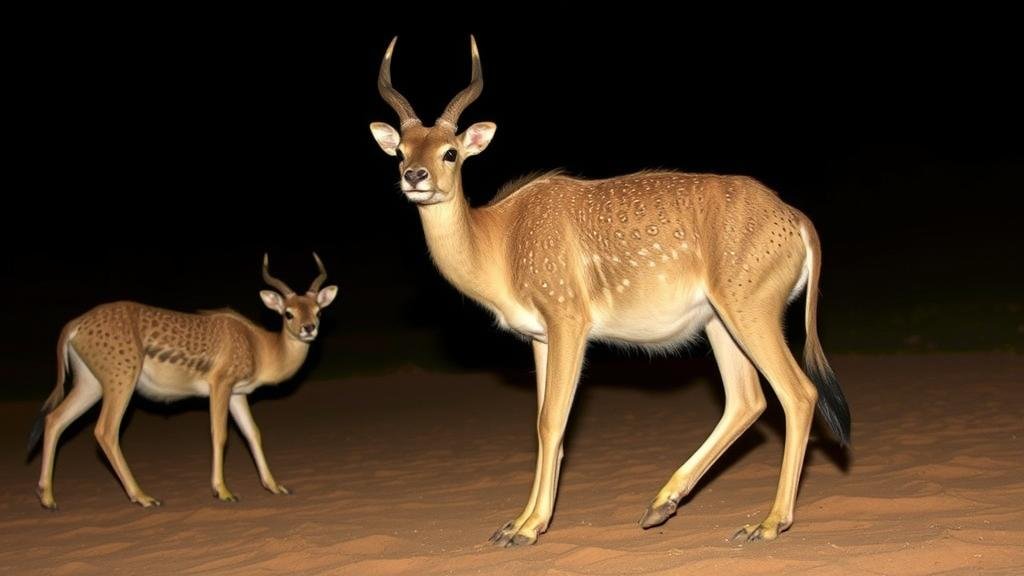Documenting nocturnal behaviors of desert animals in the Arabian sands.
Documenting Nocturnal Behaviors of Desert Animals in the Arabian Sands
The Arabian Desert, a vast and arid region covering approximately 2.33 million square kilometers, is home to a diverse range of wildlife that has adapted to its harsh conditions. Among these adaptations is a unique behavioral pattern observed in nocturnal animals. This article explores the fascinating nocturnal behaviors of desert fauna, highlighting specific species, their adaptations, and the methodologies used in documenting these vital aspects of their lives.
Nocturnal Adaptations: Surviving the Heat
In the Arabian sands, daytime temperatures can soar above 50 degrees Celsius, creating an inhospitable environment for most wildlife. To mitigate the impact of this extreme heat, many animals have evolved to become nocturnal, active during the cooler night hours.
- The Arabian Oryx, for example, feeds primarily at night when temperatures drop and vegetation is more accessible.
- Fennec foxes, another nocturnal inhabitant, are known for their large ears that dissipate heat and their ability to locate food sources in the dark.
Observations suggest that these adaptations not only facilitate survival but also influence social behaviors, hunting strategies, and mating rituals among various species.
Techniques for Documenting Nocturnal Behaviors
Documenting the behaviors of nocturnal animals in the Arabian sands poses unique challenges. Modern technology and traditional methods work in tandem to provide comprehensive insights into the lives of these elusive creatures. Three primary techniques are commonly employed:
- Night Vision Cameras: These devices are equipped with infrared technology, allowing researchers to capture images and videos of animals without disturbing their natural habitats. For example, studies on the Saadani National Park have successfully tracked Arabian leopard movements using this method.
- Radio Telemetry: Attaching lightweight radio collars to select species enables researchers to monitor their movements and behaviors in real-time. This technique has been instrumental in understanding desert fox territories and food habits.
- Observational Field Studies: Trained researchers often undertake nocturnal surveys, employing techniques such as spotlighting and auditory surveys to identify species activities. For example, the documentation of the sand gazelles mating calls has provided insights into their breeding behaviors.
Specific Examples of Nocturnal Behaviors
There are numerous fascinating nocturnal behaviors exhibited by desert animals. Here are a few noteworthy examples:
- Arabian Sand Gazelle: Known for their incredible speed, these gazelles utilize the cover of night to elude predators while foraging for grass and shrubs. Observations have indicated that groups often synchronize their movement patterns to enhance safety.
- Nocturnal Rodents: Species such as the desert gerbil have adapted to digging extensive burrow systems that provide shelter from nighttime predators and extreme temperatures. Their foraging behaviors are typically synchronized to nighttime, reducing exposure to risks.
- Horned Viper: This venomous snake is primarily nocturnal, utilizing its advanced camouflage to ambush unsuspecting prey. Studies have shown their hunting strategies peak during the early hours of the night.
Conservation Implications
Understanding the nocturnal behaviors of desert animals is crucial for their conservation. As global temperatures rise and habitats change, these animals are increasingly at risk. Effective conservation strategies must consider their unique behaviors:
- Protecting nocturnal habitats from urban development and agricultural expansion ensures these species can thrive.
- Public education about the importance of preserving these behaviors can foster community support for conservation efforts.
Conclusion: The Importance of Continued Research
Documenting the nocturnal behaviors of desert animals is not merely an academic endeavor but a crucial aspect of understanding and preserving these unique ecosystems. As technology advances and more sophisticated techniques are developed, researchers can glean deeper insights into the lives of these mysterious creatures. The Arabian sands hold secrets that, when uncovered, can inform conservation strategies, ensuring these species continue to survive in an ever-changing environment.
For those interested in wildlife conservation, engaging in or supporting research initiatives focusing on nocturnal behaviors can contribute to the protection and understanding of desert biodiversity. Awareness and action are vital as we seek to maintain the intricate balance of life within these mesmerizing, yet fraught, landscapes.



